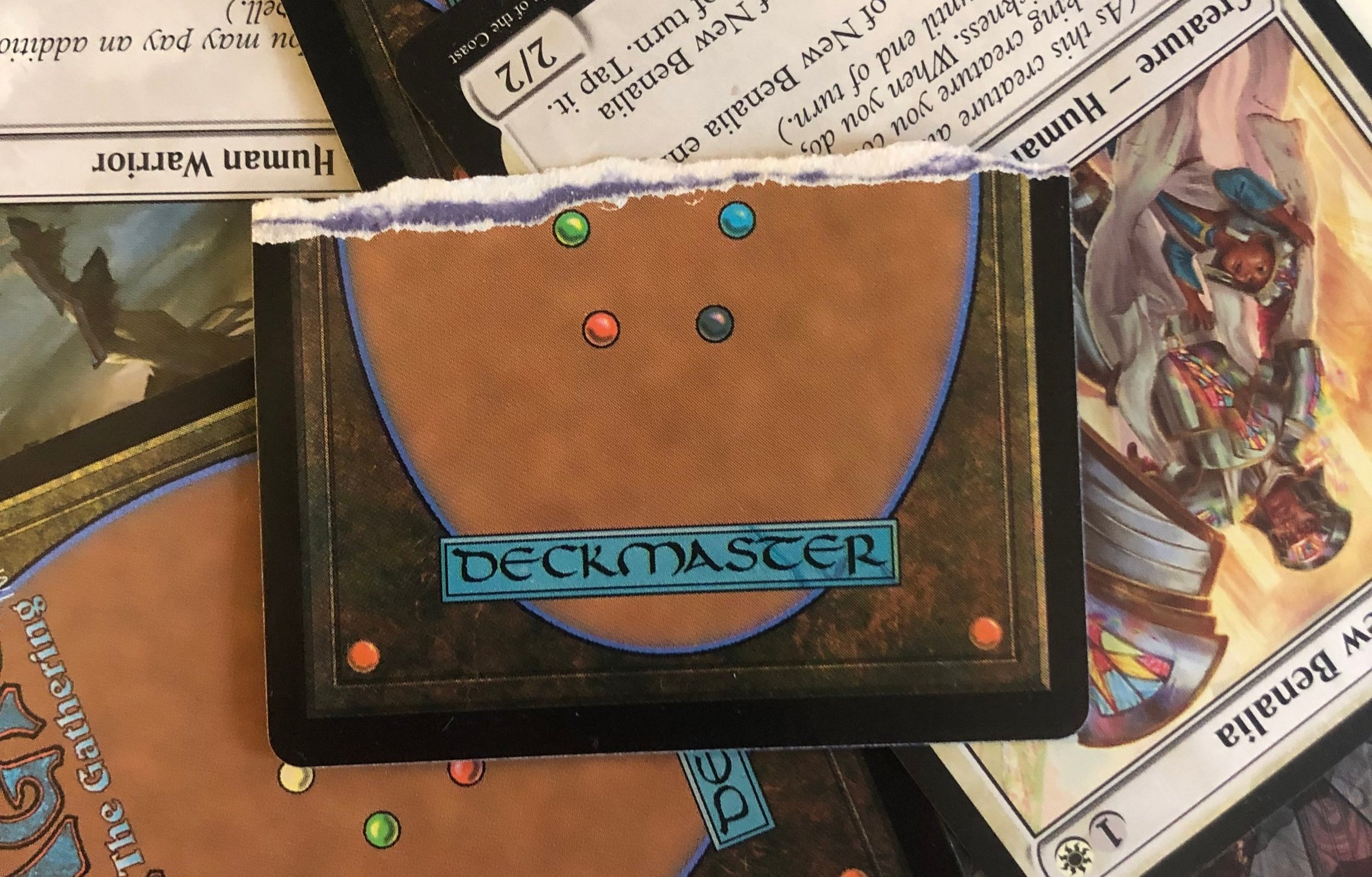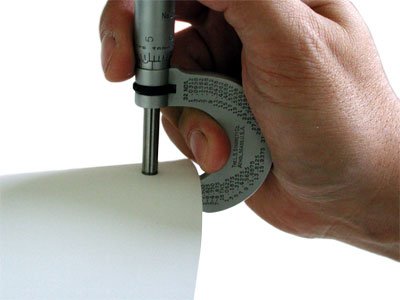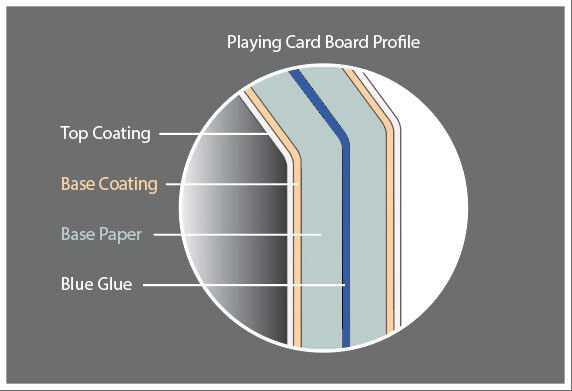Built to Last: Magic Card Tough
It started as a simple question: why do magic cards suck at shuffling?
It ended with me down a rabbit hole… Archival footage playing on a grainy TV-VCR combo in the corner. The dossiers of early WOTC confidants like Lisa Stevens, and Sean Prather scattered across my floor. My wall of veritable spiderweb of connections, conversations, conspiracy…
So, let’s get into it, why do magic cards suck at shuffling?
Technical Specifications
A lot can effect shuffle feel, card stock stiffness, weight, core, and finish. I wrote a pretty in depth look at the kinds of materials and finishes you can use on game cards: The Anatomy of a Card.
While some printings have used alternate card stock, the original and standard Mtg card stock is called Corona and has the below specs:
320 GSM
12 point
Blue core
Plastic laminate
GSM: The first thing that stands out is that magic cards are significantly heavier and thicker than standard playing cards. GSM or grams per square meter is a measure of card stock weight. It correlates with both stock thickness and density.
Typically, higher GSM stocks are less snappy and stiffer. Standard playing cards (Bicycles, Bees, etc) are 300-310 gsm. Most premium feeling board games use 280+ gsm, although it’s important to keep in mind that card sizes effect how stiff cards feel, so while mtg are close to American Poker size, many board games will use bridge, and euro cards for a lot of uses.
Points: Card stock thickness is measured in points or mils, which are 1/1000th of an inch. Mtg cards are 12 point. Again, they come in thicker than standard playing cards which are about 8 point.
One caveat here is that I was unable to find whether mtg card stock is 12 point, or cards are 0.012 inches thick including the laminate.
Together this means that mtg cards are thicker and heavier than standard playing cards. A correlate is that their fiber density is a little lower than standard cards.
Blue Core: Card stock is made by gluing two layers of paper together. The binding agent is often referred to as a plastic, but it is usually a graphite laminate. This is also called “the core”.
The core is what gives cards their “snap”, resilience to bending (less likely to crease), improved shuffle, and durability.
Most manufactures offer a number of cores, which relate to how premium the card stock is. A typical ordering would be:
Gray Core
White/Ivory Core
Blue Core
Black Core
But, this ordering isn’t universal – as there are other contributory factors to stock quality. Panda GM for instance offers Blue Core as their base line, with Ivory Core at intermediate, and Black Core as the most premium.
A major difference between core colors will be the opacity of the cards. Black Core or “casino grade” stock is designed to be completely opaque.
Plastic Laminate: After printing on card stock, a finishing layer is applied as a sealant, to protect the cards, add to the aesthetic, and durability.
There are two primary types of finishes, with a couple of sub-types:
Liquid Finishes: a liquid varnish is applied to the cards and then cured. There are three types of varnish:
Oil Based Varnish: This finishing was the historical norm.
UV Varnish: Is a varnish that is cured using UV light. UV varnish is stiffer than other types of varnish and might be more prone to cracking. Historically it has only come in high gloss, but now comes in matte finishes as well.
Aqueous Varnish: Is a water-based varnish. It’s more environmentally friendly and is the only offering at a number of manufacturers.
Laminate Finishes: are a thin film that is applied and bonded to the card stock. They typically add more thickness than liquid varnishes and can add to the stiffness of the card.
Finishes also contribute to how sticky cards are, with more matte finishes having a smoother shuffle-feel, and high gloss finishes prone to clumping.
The best shuffle-feels use a linen finish, which is application of cross hatching applied to curing varnishes. The term originates from pressing linen onto the card sheets to create the dimpling (although they use different materials now).
By creating an un-even surface (like the surface of a golf ball) the airflow around the cards is increased, improving the shuffle feel of the cards.
In aggregate, WOTC made a number of choices around their stock and finish, that aren’t ideal for shuffling. They chose a thicker, heavier, and less snappy stock. And, a plastic laminate that increases stiffness, and the potential for card clumping – instead of a matte or linen varnish.
Let’s talk about why.
What it Wasn’t
When researching this article, I asked about the history of Mtg stock on a number of forums, and ultimately tracked down some authoritative sources like Jesper Myrfors & Tavis King.
Among the good information was a bunch of unsubstantiated claims, and theories, some of which sound plausible.
An anti-counterfeiting measure: Card stock is heavy, and so expensive to transport over long distances. When contracting with Cartamundi for those first print runs, the stocks that WOTC would have looked at would mostly be local to Europe (Cartamundi is Belgium based).
The original Corona stock was manufactured in both France and Germany. While it wouldn’t be WOTC’s only stock option, it wasn’t made specifically for WOTC, and was and is available for other producers to purchase.
Collation Machines: Magic cards are printed in sheets, which are cut, and then go through a collation machine to create the “random” distribution we see in packs. Cartamundi used the collation machines that had been developed for trading cards.
Trading cards like baseball cards are substantially thicker than playing cards or magic cards at ~20+ points. The machines are essentially conveyer belts and rollers, and can handle a range of stock weight and thickness from thinner than magic cards, up through trading cards.
Here is an excellent interview with Peter Adkison and Luc Mertens on the early days of Wizards and Cartamundi’s partnership.
Tougher than an 0/8 Wall of Stone
At the end of the day, it came down to durability.
Vic Wertz ultimately chose the 320 gsm, blue core stock, and importantly the plastic laminate. His rep and counterpart at Cartamundi was Luc Mertens – who would have provided WOTC with a range of samples along with his expertise.
While I was unable to reach Vic for comment, I did manage to corner Jesper Myrfors on Facebook.
When designing games we face a lot of complicated choices. And, often maximizing for one variable means that we need to de-prioritize others.
Vic and Wizards chose durability over shuffle feel. And, 30 years later, in a world in a world of sleeves, where cards are worth hundreds and thousands of dollars, I think we can all appreciate sacrificing a little smoothness to ensure that our cards have held up to the rigors of thirty years of play.
Frequent blog readers will know that I am a pretty avid mtg player. And, our next game happens to be designed by a former mtg Pro Tour player. If you love magic cards as much as we do, I’d encourage checking out our upcoming board game Sigil. While it isn’t coming to Kickstarter until ~March 2023, we have a free to play digital version that you can check out now: sigilbattle.com.
What games have your favorite card stock?





